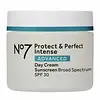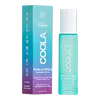What's inside
What's inside
 Key Ingredients
Key Ingredients

 Benefits
Benefits

 Concerns
Concerns

 Ingredients Side-by-side
Ingredients Side-by-side

Water
Skin ConditioningGlycerin
HumectantC12-15 Alkyl Benzoate
AntimicrobialOctocrylene
UV AbsorberButyl Methoxydibenzoylmethane
UV AbsorberCetearyl Glucoside
EmulsifyingDimethicone
EmollientAluminum Starch Octenylsuccinate
AbsorbentEthylhexyl Salicylate
UV AbsorberAlcohol Denat.
AntimicrobialButylene Glycol
HumectantAmmonium Acryloyldimethyltaurate/Vp Copolymer
Phenoxyethanol
PreservativeTribehenin
EmollientButyrospermum Parkii Butter
Skin ConditioningBis-Ethylhexyloxyphenol Methoxyphenyl Triazine
Skin ConditioningPotassium Cetyl Phosphate
EmulsifyingMethylparaben
PreservativeDimethiconol
EmollientParfum
MaskingPropylene Glycol
HumectantXanthan Gum
EmulsifyingTocopheryl Acetate
AntioxidantSodium Hyaluronate
HumectantEthylparaben
PreservativeDiethylhexyl Butamido Triazone
UV AbsorberAscorbyl Glucoside
AntioxidantDipropylene Glycol
HumectantRetinyl Palmitate
Skin ConditioningHydrolyzed Rice Protein
Skin ConditioningTetrasodium EDTA
Sorbitan Laurate
EmulsifyingT-Butyl Alcohol
PerfumingPanax Ginseng Root Extract
EmollientCarbomer
Emulsion StabilisingDimethylmethoxy Chromanol
AntioxidantPotassium Hydroxide
BufferingMedicago Sativa Extract
TonicPolysorbate 20
EmulsifyingHydroxyethylcellulose
Emulsion StabilisingMorus Alba Leaf Extract
Skin ConditioningSilica
AbrasiveSodium Benzoate
MaskingTocopherol
AntioxidantAcetyl Dipeptide-1 Cetyl Ester
Skin ConditioningEthylhexylglycerin
Skin ConditioningPalmitoyl Tripeptide-1
Skin ConditioningPalmitoyl Tetrapeptide-7
Skin ConditioningWater, Glycerin, C12-15 Alkyl Benzoate, Octocrylene, Butyl Methoxydibenzoylmethane, Cetearyl Glucoside, Dimethicone, Aluminum Starch Octenylsuccinate, Ethylhexyl Salicylate, Alcohol Denat., Butylene Glycol, Ammonium Acryloyldimethyltaurate/Vp Copolymer, Phenoxyethanol, Tribehenin, Butyrospermum Parkii Butter, Bis-Ethylhexyloxyphenol Methoxyphenyl Triazine, Potassium Cetyl Phosphate, Methylparaben, Dimethiconol, Parfum, Propylene Glycol, Xanthan Gum, Tocopheryl Acetate, Sodium Hyaluronate, Ethylparaben, Diethylhexyl Butamido Triazone, Ascorbyl Glucoside, Dipropylene Glycol, Retinyl Palmitate, Hydrolyzed Rice Protein, Tetrasodium EDTA, Sorbitan Laurate, T-Butyl Alcohol, Panax Ginseng Root Extract, Carbomer, Dimethylmethoxy Chromanol, Potassium Hydroxide, Medicago Sativa Extract, Polysorbate 20, Hydroxyethylcellulose, Morus Alba Leaf Extract, Silica, Sodium Benzoate, Tocopherol, Acetyl Dipeptide-1 Cetyl Ester, Ethylhexylglycerin, Palmitoyl Tripeptide-1, Palmitoyl Tetrapeptide-7
Butyl Methoxydibenzoylmethane 2.8%
UV AbsorberHomosalate 3.5%
Skin ConditioningEthylhexyl Salicylate 3.9%
UV AbsorberAlcohol
AntimicrobialIsodecyl Neopentanoate
EmollientDicaprylyl Carbonate
EmollientDiisopropyl Adipate
EmollientSilica
AbrasiveSilica Silylate
EmollientCitrus Aurantium Dulcis Fruit Water
MaskingSodium Hyaluronate
HumectantHelianthus Annuus Seed Oil
EmollientPhoenix Dactylifera Leaf Cell Extract
MaskingPaeonia Lactiflora Leaf Cell Extract
AntioxidantJuniperus Communis Callus Extract
AntioxidantCucumis Sativus Fruit Extract
EmollientLaminaria Digitata Extract
Skin ProtectingAloe Barbadensis Leaf Extract
EmollientGlycerin
HumectantWater
Skin ConditioningEthyl Ferulate
AntioxidantPvp
Emulsion StabilisingParfum
MaskingButyl Methoxydibenzoylmethane 2.8%, Homosalate 3.5%, Ethylhexyl Salicylate 3.9%, Alcohol, Isodecyl Neopentanoate, Dicaprylyl Carbonate, Diisopropyl Adipate, Silica, Silica Silylate, Citrus Aurantium Dulcis Fruit Water, Sodium Hyaluronate, Helianthus Annuus Seed Oil, Phoenix Dactylifera Leaf Cell Extract, Paeonia Lactiflora Leaf Cell Extract, Juniperus Communis Callus Extract, Cucumis Sativus Fruit Extract, Laminaria Digitata Extract, Aloe Barbadensis Leaf Extract, Glycerin, Water, Ethyl Ferulate, Pvp, Parfum
 Reviews
Reviews

Ingredients Explained
These ingredients are found in both products.
Ingredients higher up in an ingredient list are typically present in a larger amount.
Also known as Avobenzone, this ingredient is a chemical sunscreen filter that provides protection in the UV-A range.
Avobenzone is globally approved and is the most commonly used UV-A filter in the world.
Studies have found that avobenzone becomes ineffective when exposed to UV light (it is not photostable; meaning that it breaks down in sunlight). Because of this, formulations that include avobenzone will usually contain stabilizers such as octocrylene.
However, some modern formulations (looking at you, EU!) are able to stabilize avobenzone by coating the molecules.
Avobenzone does not protect against the UV-B range, so it's important to check that the sunscreen you're using contains other UV filters that do!
The highest concentration of avobenzone permitted is 3% in the US, and 5% in the EU.
Learn more about Butyl MethoxydibenzoylmethaneEthylhexyl Salicylate is an organic compound used to block UV rays. It primarily absorbs UVB rays but offers a small amount of UVA protection as well.
Commonly found in sunscreens, Ethylhexyl Salicylate is created from salicylic acid and 2-ethylhexanol. You might know salicylic acid as the effective acne fighter ingredient and BHA.
The ethylhexanol in this ingredient is a fatty alcohol and helps hydrate your skin, similar to oils. It is an emollient, which means it traps moisture into the skin.
According to manufacturers, Ethylhexyl Salicylate absorbs UV wavelength of 295-315 nm, with a peak absorption at 307-310 nm. UVA rays are linked to long term skin damage, such as hyperpigmentation. UVB rays emit more energy and are capable of damaging our DNA. UVB rays cause sunburn.
Learn more about Ethylhexyl SalicylateGlycerin is already naturally found in your skin. It helps moisturize and protect your skin.
A study from 2016 found glycerin to be more effective as a humectant than AHAs and hyaluronic acid.
As a humectant, it helps the skin stay hydrated by pulling moisture to your skin. The low molecular weight of glycerin allows it to pull moisture into the deeper layers of your skin.
Hydrated skin improves your skin barrier; Your skin barrier helps protect against irritants and bacteria.
Glycerin has also been found to have antimicrobial and antiviral properties. Due to these properties, glycerin is often used in wound and burn treatments.
In cosmetics, glycerin is usually derived from plants such as soybean or palm. However, it can also be sourced from animals, such as tallow or animal fat.
This ingredient is organic, colorless, odorless, and non-toxic.
Glycerin is the name for this ingredient in American English. British English uses Glycerol/Glycerine.
Learn more about GlycerinParfum is a catch-all term for an ingredient or more that is used to give a scent to products.
Also called "fragrance", this ingredient can be a blend of hundreds of chemicals or plant oils. This means every product with "fragrance" or "parfum" in the ingredients list is a different mixture.
For instance, Habanolide is a proprietary trade name for a specific aroma chemical. When used as a fragrance ingredient in cosmetics, most aroma chemicals fall under the broad labeling category of “FRAGRANCE” or “PARFUM” according to EU and US regulations.
The term 'parfum' or 'fragrance' is not regulated in many countries. In many cases, it is up to the brand to define this term.
For instance, many brands choose to label themselves as "fragrance-free" because they are not using synthetic fragrances. However, their products may still contain ingredients such as essential oils that are considered a fragrance by INCI standards.
One example is Calendula flower extract. Calendula is an essential oil that still imparts a scent or 'fragrance'.
Depending on the blend, the ingredients in the mixture can cause allergies and sensitivities on the skin. Some ingredients that are known EU allergens include linalool and citronellol.
Parfum can also be used to mask or cover an unpleasant scent.
The bottom line is: not all fragrances/parfum/ingredients are created equally. If you are worried about fragrances, we recommend taking a closer look at an ingredient. And of course, we always recommend speaking with a professional.
Learn more about ParfumSilica, also known as silicon dioxide, is a naturally occurring mineral. It is used as a fine, spherical, and porous powder in cosmetics.
Though it has exfoliant properties, the function of silica varies depending on the product.
The unique structure of silica enhances the spreadability and adds smoothness, making it a great texture enhancer.
It is also used as an active carrier, emulsifier, and mattifier due to its ability to absorb excess oil.
In some products, tiny microneedles called spicules are made from silica or hydrolyzed sponge. When you rub them in, they lightly polish away dead skin layers and enhance the penetration of active ingredients.
Learn more about SilicaSodium Hyaluronate is hyaluronic acid's salt form. It is commonly derived from the sodium salt of hyaluronic acid.
Like hyaluronic acid, it is great at holding water and acts as a humectant. This makes it a great skin hydrating ingredient.
Sodium Hyaluronate is naturally occurring in our bodies and is mostly found in eye fluid and joints.
These are some other common types of Hyaluronic Acid:
Learn more about Sodium HyaluronateWater. It's the most common cosmetic ingredient of all. You'll usually see it at the top of ingredient lists, meaning that it makes up the largest part of the product.
So why is it so popular? Water most often acts as a solvent - this means that it helps dissolve other ingredients into the formulation.
You'll also recognize water as that liquid we all need to stay alive. If you see this, drink a glass of water. Stay hydrated!
Learn more about Water